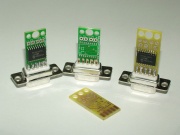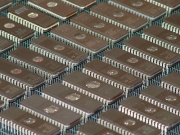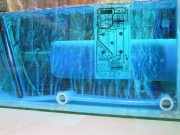| Microchip PIC MicroControllers The bulk of the 'thinking' projects here are written in RISC assembly language for the 16F 8-bit PIC range. It is a processor which I have become used to over the years despite it's bank switching and memory map, which is somewhat confusing for beginners. I do not program in C' with any of the Microchip range as I prefer the control that assembly language gives you. I also work with the dsPIC 30F 16-bit processors, particularly when emulating hard drives, as the 8-bit processors neither have the speed, instructions, or available I/O. The 8-bit processors operate at about 1MIPs in their standard 4Mhz configuration, with the 16-bit processors running at about 30MIPs in their 120Mhz configuration. A quirk of the Microchip range is that an instruction cycle takes Mhz/4. However, most instrctions only take 1 cycle when compared to the competition. Bang for the buck the PICs are faster and more capable, but are quite obscure to program for. | |  |




